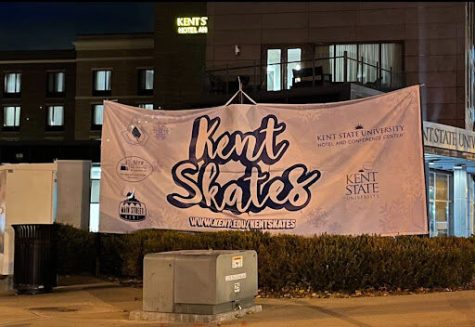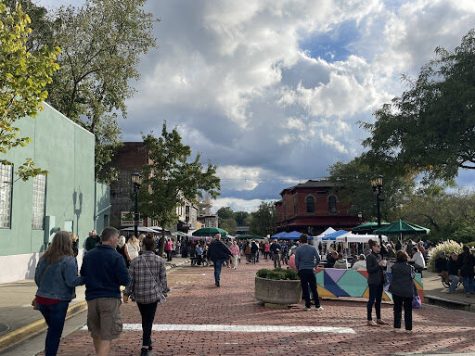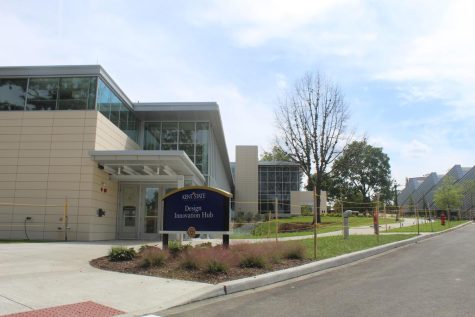That Kent State quarantine grind: Kent State’s changes to the typical fall semester
August 13, 2020
As students head into the fall semester facing uncertainty, countless questions pile up — all wondering in the end — what will happen next?
The COVID Response Team is a newly created task force to help answer these questions and help students understand what the next step is when it comes to testing for COVID-19, along with managing the health situation on campus. Located in University Health Services, the team will work with the city of Kent and the local health department to ensure Kent State community members’ safety.
Currently, the university is in the process of hiring a case manager to help oversee everything for the team. In addition to the case manager, there will be several nurses on the team and Dr. Lisa Dannemiller, Chief University Physician.
In addition to the COVID Response Team, Kent State is continuing to make changes throughout the campus, including in the classrooms, dining halls, residence halls and implementing the Flashes Safe Seven guidelines.
Changes to Campus
As Kent State students hurried off campus and returned home in the spring, there was barely a second to take a look back at the campus they were leaving prematurely. In the minds of students, the esplanade is filled with people, students are looking for an empty seat in their classrooms and the line in the dining halls seems to be never ending. But now, campus will look a bit different.
“What you’ll sort of see is a lot of efforts to decrease density on campus and increase safety,” said Manfred van Dulmen, chair on the Reopening Steering Committee.
Anyone who has the option of staying remote, whether that is a staff member, instructors or students are all encouraged to do so.
Signs are being installed throughout campus, reminding people about the Flashes Safe Seven guidelines and physical distancing rules.
Stickers will be placed in all classrooms to adhere to the physical distancing rules, as well. Green stickers will be placed on chairs where students can sit, while red stickers will be placed where students cannot sit.
Changes to the Beverly J. Warren Student Recreation and Wellness Center and the dining halls will reflect reduced capacity and follow the Flashes Safe Seven guidelines.
Changes to Residence Halls
There is nothing quite like move-in day. The lines of cars, carts stacked with boxes and RAs checking in their residents with a big smile on their faces.
Due to COVID-19, move-in day has changed from the typical one day event and is now spread over five days. Beginning on August 19, residents moved in on staggered days and times depending on their last name and room number.
“That way we [could] minimize students arriving at any given time on campus,” said Jill Jenkins, executive director for Residence Services.
Last year, move-in day had approximately 4,000 students moving into all 24 residence halls, all at once on the same day. This year, over the five days, each day had less than 1000 students moving in at once. In addition, last year there were about 6,500 students living in residence halls, this year there are approximately 4,200 students. Not every room is occupied and the triple room option was eliminated, meaning there will only be one or two students living in each room.
In the past, there was overflow housing — meaning some students would start off the semester living in lounges and different temporary rooms until there was a permanent room available. Now, residence services has committed to no overflow housing.
RAs will attend their two week training before students move in, where they will be learning about the Flashes Safe Seven and the appropriate measures to be taken when residents are not following the guidelines.
“When they see students who aren’t following [Flashes Safe Seven], they would address it similar to when they see a student not following the noise policy,” Jenkins said.
Most RAs no longer have a roommate. Many RAs were notified of this change at the beginning of the summer.
Residence hall activities, such as RA-led get togethers, will continue with the majority of them being virtual. Some will continue to be in-person, with proper social distancing, face masks and following the Flashes Safe Seven guidelines. Those in person events are to be determined.
In the case a student living in the residence halls tests positive for COVID-19, has been in proximity of someone who has tested positive or has symptoms, they should contact the COVID Response Team. With approval from the response team, in certain cases students may be allowed to quarantine in their room.
“The university has allocated space on campus for students living in the residence halls to safely isolate if they are diagnosed with COVID-19,” stated Manfred van Dulmen in an email to Kent State students on Aug. 3.
In that case, the university will provide linens and food to those students who are isolated.
“We want everybody to make sure they’re taking care of each other, taking their personal precautions but also thinking about those around them,” Jenkins said.
Reaching out to the COVID Response Team
The COVID Response Team will become the hub for any questions and information regarding COVID-19 on all Kent State campuses. The COVID Response Team can be contacted at 330-672-2525.
The response team should be contacted in the case you have tested positive or are being tested for the virus, have had close contact [within six feet of an infected person for more than 15 minutes] with someone who has tested positive, live in university housing with symptoms consistent with COVID or have traveled internationally or are returning to Ohio from somewhere with more than 15 percent positive cases.
If you have been in close contact with a positive COVID-19 case, you will be notified by the local health department or the COVID Response Team to be advised in what will be the next step for quarantine. Health departments are responsible for doing contact tracing on all positive cases. The COVID Response Team will assist to find the contacts as quickly as possible.
Depending on the situation, the COVID Response Team will help determine whether or not to isolate or quarantine.
If someone is sick with COVID-19 or has tested positive with no symptoms, they should go into isolation. This means they will be isolating themselves from others to avoid any possible spread.
If someone has possibly been exposed to COVID-19 or has been tested for COVID-19, they should go into quarantine to help prevent the spread. In quarantine, this means that the person might have been in contact and want to ensure that they do not have the virus.
Due to the Health Insurance Portability and Accountability Act [HIPAA] and the Family Educational Rights and Privacy Act [FERPA], if there is a positive case on campus, it will remain confidential. In the case you were in close contact with the positive case or are learning, living or working in a space where exposure has occurred, you will be notified about cleaning procedures, which will follow the CDC guidelines.
As opposed to the spring semester with the sudden shutdown, in the event campus has to shut down, it is more likely to be in smaller closures rather than a full shutdown, depending on the size of the outbreak. Every scenario becomes different with what the outbreak is like and how the team can handle it. For example, in the case that there is a smaller outbreak in one of the dorms, the team will then work to see if there is a possibility of smaller closures before a full shutdown.
If a building is closed, building managers will notify anyone who works, attends classes or activities in or around the building. In the notification that is sent to the building manager, it will include the area affected by the closure, as well as the duration of the closure.
“Every situation is different and it depends how many people it involves — do they live in the residence halls, where [have] they been on campus,” van Dulmen said. “The COVID-19 response team will work with the health department to determine — do we need to close off a building for a week? Do we need to close off some rooms?”
Changes to the DeWeese Health Center
While there are a few different options for Kent State students, faculty and staff to get tested, whether that be at their local CVS or their primary care doctor’s office, one of the bigger changes on campus is DeWeese Health Center’s ability to test for COVID-19.
Students, staff and faculty can receive a COVID-19 test at the DeWeese Health Center after a telemedicine visit with a clinician. Patients must call ahead at 330-672-2322 to schedule a telemedicine visit. The clinician will then order the test for the patient. Walk-ins are not currently available.
Modifications have been made to the health center with a negative pressure room, along with an outside trailer, both serving as testing facilities.
Testing is for people who have symptoms, people in close contact with others who have tested positive and people at risk. Additionally, testing is available to people who may need it as a requirement for internships and other activities.
In addition, a different team, which is in the early stages of development, is being created that will meet daily to discuss what is happening on campus, if there are any adjustments to be made and if the team would need to reach out to University President Todd Diacon about changing operations.
“We’ve been very fortunate to have several international public health experts on campus, some incredible medical health providers and to think about what we need to put in place for this to be successful, and I think having a team that’s dedicated to this is going to be critical,” van Dulmen said.
Heading into the fall semester
The State of Ohio has recently changed the travel guidance for people coming into Ohio from other states that have a positive testing rate of 15 percent or higher. For these people that are now entering Ohio, they must self quarantine for 14 days upon arrival. This travel guidance also applies to any Kent State students coming onto campus.
As of Aug. 13, those states are Texas, Florida, Idaho, Alabama, Missouri and Nevada, all information can be found on the Ohio Department of Health’s website.
“There’s an expectation that they self quarantine for 14 days and wait to come to campus until that time period has reached out,” van Dulmen said. “Once they come into Ohio, they reach out to the COVID-19 response team and see whether they should be tested or not.”
Residence Services has created a plan for Kent State students living on campus to come two weeks early to self quarantine.
Once students call the COVID Response Team, they will be instructed on what they need to do next. The response team will then work with Kent Residence Services and University Dining Services to change their contract dates to ensure an early move-in and meal delivery during this 14-day period. The hope is to keep these students in the room they are self-quarantining in for the full 14 days.
Once students come onto campus, Kent State will be providing two washable masks with the Kent State logo. Students moving into the residence halls will be receiving their masks in the care package given at the beginning of the fall semester. For students not living in the dorms, there will be pick up spots for their masks and they will be notified where they can pick them up via email.
“We want to keep everybody able to be together, and a really key part of that is having [them] wearing face coverings,” van Dulmen said.
A mask mandate in Kent, Ohio was passed on July 16, meaning masks are mandatory throughout public places in Kent.
“I think that the biggest hope and the most important thing is that everybody stays safe and healthy, that’s first and foremost,” van Dulmen said. “In addition to that, despite this being a very challenging time, everybody who is engaged in the university community has a good experience and can move forward on their educational goals, their research goals, whatever they want to do, but I think that the safety and health is the most important piece.”


















